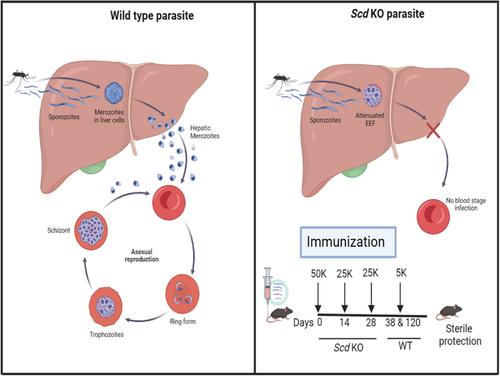当前位置:
X-MOL 学术
›
Mol. Microbiol.
›
论文详情
Our official English website, www.x-mol.net, welcomes your feedback! (Note: you will need to create a separate account there.)
Stearoyl-CoA desaturase regulates organelle biogenesis and hepatic merozoite formation in Plasmodium berghei
Molecular Microbiology ( IF 3.6 ) Pub Date : 2024-02-28 , DOI: 10.1111/mmi.15246 Sunil Kumar Narwal 1 , Akancha Mishra 1, 2 , Raksha Devi 1, 2 , Ankit Ghosh 1 , Hadi Hasan Choudhary 1 , Satish Mishra 1, 2
Molecular Microbiology ( IF 3.6 ) Pub Date : 2024-02-28 , DOI: 10.1111/mmi.15246 Sunil Kumar Narwal 1 , Akancha Mishra 1, 2 , Raksha Devi 1, 2 , Ankit Ghosh 1 , Hadi Hasan Choudhary 1 , Satish Mishra 1, 2
Affiliation

|
Plasmodium is an obligate intracellular parasite that requires intense lipid synthesis for membrane biogenesis and survival. One of the principal membrane components is oleic acid, which is needed to maintain the membrane's biophysical properties and fluidity. The malaria parasite can modify fatty acids, and stearoyl-CoA Δ9-desaturase (Scd) is an enzyme that catalyzes the synthesis of oleic acid by desaturation of stearic acid. Scd is dispensable in P. falciparum blood stages; however, its role in mosquito and liver stages remains unknown. We show that P. berghei Scd localizes to the ER in the blood and liver stages. Disruption of Scd in the rodent malaria parasite P. berghei did not affect parasite blood stage propagation, mosquito stage development, or early liver-stage development. However, when Scd KO sporozoites were inoculated intravenously or by mosquito bite into mice, they failed to initiate blood-stage infection. Immunofluorescence analysis revealed that organelle biogenesis was impaired and merozoite formation was abolished, which initiates blood-stage infections. Genetic complementation of the KO parasites restored merozoite formation to a level similar to that of WT parasites. Mice immunized with Scd KO sporozoites confer long-lasting sterile protection against infectious sporozoite challenge. Thus, the Scd KO parasite is an appealing candidate for inducing protective pre-erythrocytic immunity and hence its utility as a GAP.
中文翻译:

硬脂酰辅酶A去饱和酶调节伯氏疟原虫的细胞器生物发生和肝裂殖子形成
疟原虫是一种专性细胞内寄生虫,需要大量的脂质合成来实现膜的生物发生和生存。膜的主要成分之一是油酸,它是维持膜的生物物理特性和流动性所必需的。疟原虫可以修饰脂肪酸,硬脂酰辅酶A Δ9-去饱和酶(Scd)是一种通过硬脂酸去饱和来催化油酸合成的酶。 Scd 在恶性疟原虫血期中是可有可无的;然而,它在蚊子和肝脏阶段的作用仍然未知。我们发现伯氏疟原虫Scd 定位于血液和肝脏阶段的 ER。啮齿动物疟疾寄生虫伯氏疟原虫中Scd的破坏不会影响寄生虫的血液阶段繁殖、蚊子阶段发育或早期肝脏阶段发育。然而,当Scd KO子孢子通过静脉注射或通过蚊虫叮咬接种到小鼠体内时,它们未能引发血液阶段感染。免疫荧光分析显示,细胞器生物发生受损,裂殖子形成被消除,从而引发血液阶段感染。 KO 寄生虫的基因互补将裂殖子形成恢复到与 WT 寄生虫相似的水平。用Scd KO 子孢子免疫的小鼠可针对传染性子孢子的攻击提供持久的无菌保护。因此,Scd KO 寄生虫是诱导保护性红细胞前免疫的有吸引力的候选者,因此它可用作 GAP。
疟原虫是一种专性细胞内寄生虫,需要大量的脂质合成来实现膜的生物发生和生存。膜的主要成分之一是油酸,它是维持膜的生物物理特性和流动性所必需的。疟原虫可以修饰脂肪酸,硬脂酰辅酶A Δ9-去饱和酶(Scd)是一种通过硬脂酸去饱和来催化油酸合成的酶。 Scd 在恶性疟原虫血期中是可有可无的;然而,它在蚊子和肝脏阶段的作用仍然未知。我们发现伯氏疟原虫 Scd 定位于血液和肝脏阶段的 ER。啮齿动物疟疾寄生虫伯氏疟原虫中 Scd 的破坏不会影响寄生虫的血液阶段繁殖、蚊子阶段发育或早期肝脏阶段发育。然而,当Scd KO子孢子通过静脉注射或通过蚊虫叮咬接种到小鼠体内时,它们未能引发血液阶段感染。免疫荧光分析显示,细胞器生物发生受损,裂殖子形成被消除,从而引发血液阶段感染。 KO 寄生虫的基因互补将裂殖子形成恢复到与 WT 寄生虫相似的水平。用 Scd KO 子孢子免疫的小鼠可针对传染性子孢子的攻击提供持久的无菌保护。因此,Scd KO 寄生虫是诱导保护性红细胞前免疫的有吸引力的候选者,因此它可用作 GAP。
更新日期:2024-02-28
中文翻译:

硬脂酰辅酶A去饱和酶调节伯氏疟原虫的细胞器生物发生和肝裂殖子形成
疟原虫是一种专性细胞内寄生虫,需要大量的脂质合成来实现膜的生物发生和生存。膜的主要成分之一是油酸,它是维持膜的生物物理特性和流动性所必需的。疟原虫可以修饰脂肪酸,硬脂酰辅酶A Δ9-去饱和酶(Scd)是一种通过硬脂酸去饱和来催化油酸合成的酶。 Scd 在恶性疟原虫血期中是可有可无的;然而,它在蚊子和肝脏阶段的作用仍然未知。我们发现伯氏疟原虫Scd 定位于血液和肝脏阶段的 ER。啮齿动物疟疾寄生虫伯氏疟原虫中Scd的破坏不会影响寄生虫的血液阶段繁殖、蚊子阶段发育或早期肝脏阶段发育。然而,当Scd KO子孢子通过静脉注射或通过蚊虫叮咬接种到小鼠体内时,它们未能引发血液阶段感染。免疫荧光分析显示,细胞器生物发生受损,裂殖子形成被消除,从而引发血液阶段感染。 KO 寄生虫的基因互补将裂殖子形成恢复到与 WT 寄生虫相似的水平。用Scd KO 子孢子免疫的小鼠可针对传染性子孢子的攻击提供持久的无菌保护。因此,Scd KO 寄生虫是诱导保护性红细胞前免疫的有吸引力的候选者,因此它可用作 GAP。
疟原虫是一种专性细胞内寄生虫,需要大量的脂质合成来实现膜的生物发生和生存。膜的主要成分之一是油酸,它是维持膜的生物物理特性和流动性所必需的。疟原虫可以修饰脂肪酸,硬脂酰辅酶A Δ9-去饱和酶(Scd)是一种通过硬脂酸去饱和来催化油酸合成的酶。 Scd 在恶性疟原虫血期中是可有可无的;然而,它在蚊子和肝脏阶段的作用仍然未知。我们发现伯氏疟原虫 Scd 定位于血液和肝脏阶段的 ER。啮齿动物疟疾寄生虫伯氏疟原虫中 Scd 的破坏不会影响寄生虫的血液阶段繁殖、蚊子阶段发育或早期肝脏阶段发育。然而,当Scd KO子孢子通过静脉注射或通过蚊虫叮咬接种到小鼠体内时,它们未能引发血液阶段感染。免疫荧光分析显示,细胞器生物发生受损,裂殖子形成被消除,从而引发血液阶段感染。 KO 寄生虫的基因互补将裂殖子形成恢复到与 WT 寄生虫相似的水平。用 Scd KO 子孢子免疫的小鼠可针对传染性子孢子的攻击提供持久的无菌保护。因此,Scd KO 寄生虫是诱导保护性红细胞前免疫的有吸引力的候选者,因此它可用作 GAP。































 京公网安备 11010802027423号
京公网安备 11010802027423号